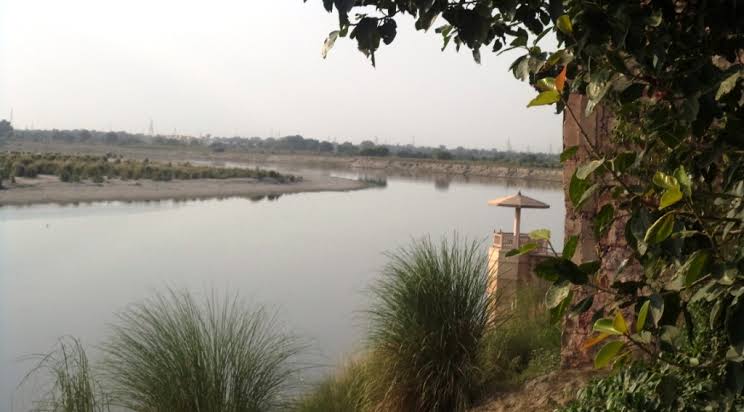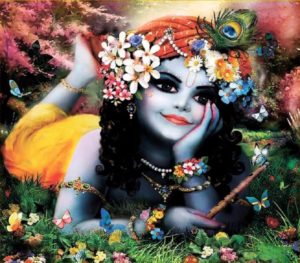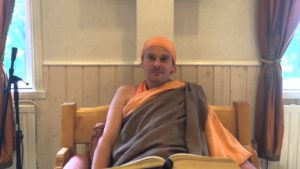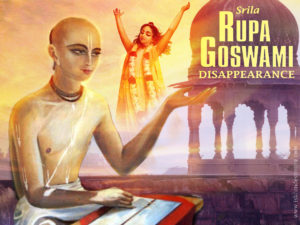Hare Krishna dear devotees,
Let us hear the glories of Yamuna, how dear she is to the devotees of Krishna and what amazing role she plays in Krishna’s Vraja pastimes. Simply hearing her glories can ignite the spark of love for Krishna in our barren hearts.
Yamuna’s Beauty
The Yamuna river passes through that forest and flows near Nandisvara Hill. It winds through Vraja in a very crooked course, searching for Sri Krsna, the moon of Vraja.
The Yamuna river is like a blue lotus flower garland, a sapphire necklace, or a blue sash worn by the goddess of Vrndavana.
(Sri Vrjaja Riti Cintamani, chapter 2, verse 33 & 40 )
Yamuna’s journey
Passing the seven seas and seven planetary systems, and breaking through the sevenfold covering of the universe, the Yamuna enters the spiritual Goloka planet and wanders here and there to serve Vrndavana by carrying water.
Many greedy men will wait at a rich man’s doorstep, hoping to meet him and benefit hundreds of thousands of times over. In the same way the Yamuna flows in a very winding course, greedy to get some of the wealth of Vrindavan forest.
(Sri Vrjaja Riti Cintamani, chapter 2, verse 41-42 )
Her pastimes with Krishna
The dark nectar current of the Yamuna picks up Lord Krsna and plunges Him and His gopi friends in the dark nectar current of transcendental amorous pastimes.
The dark nectar current of the Yamuna picks up Lord Krsna and plunges Him and His gopi friends in the dark nectar current of transcendental amorous pastimes.
Many charming aquatic creatures, plunged in the nectar of love for Krsna, again and again push their heads above the Yamuna’s waters, hoping for a glimpse of Lord Syama.
On the Yamuna s beautiful shores are jewel staircases, which are like the teeth of the goddess of beauty, and which remind one of Sri Krsna.
When they drink the sound of Krsna’s flute, these two jewel staircases melt with love, and the river flowing between them becomes solid and stunned with ecstasy.
In the moonlight the Yamuna’s beaches appear to be made of camphor-sand. Lord Krsna enjoyed His rasa-lila on these beaches, with each place bearing the name of a particular pastime.
(Sri Vrjaja Riti Cintamani, chapter 2, verse 43-47 )
The benediction
They who offer respectful obeisances to her or bathe in her waters, the Yamuna, which is like a moat of black mascara encircling Vrndavana, transforms into pure devotees carrying Lord Krsna in their hearts.
(Sri Vrjaja Riti Cintamani, chapter 2, verse 39 )
There are many ways we can offer our respectful obeisances to Yamuna, a good way is to pray to her. One prayer I can share is Yamunastakam, written by Srila Rupa Goswami. Coming from the heart of Srila Rupa Goswami we can understand its potency. And he requests her to flood that person with pure devotional service who recites these eight prayers with a cheerful heart.
Sri Sri Yamunastakam
bhratur antakasya pattane ’bhipatti-harini
preksayati-papino ’pi papa-sindhu-tarini
nira-madhuribhir apy asesa-citta-bandhini
mam punatu sarvadaravinda-bandhu-nandini
“May Yamunadevi, the daughter of Suryadeva, always purify me. She saves all, who touch her, from going to the realm of her brother Yamaraja, and enables even greatly wicked persons, who see her, to cross the ocean of their sinful deeds. Her attractive water charms the hearts of everyone.”
hari-vari-dharayabhimanditoru-khandava
pundarika-mandalodyad-andajali-tandava
snana-kama-pamarogra-papa-sampad-andhini
mam punatu sarvadaravinda-bandhu-nandini
“Yamunadevi adorns Indra’s great Khandava forest with her enchanting current, and upon her blooming lotus flowers, various birds are always dancing. Simply desiring to bath in her pleasant, crystalline waters frees one from even the greatest of sins. May Yamunadevi, the daughter of Suryadeva, always purify me.”
sikarabhimrista-jantu-durvipaka-mardini
nanda-nandanantaranga-bhakti-pura-vardhini
tira-sangamabhilasi-mangalanubandhini
mam punatu sarvadaravinda-bandhu-nandini
“Sprinkling a single drop of her water upon oneself destroys the reaction of most heinous crimes. She increases the flow of confidential devotional service (raganuga-bhakti) for Nandanandana within one’s heart and blesses everyone who simply desires to reside on her banks. May Yamunadevi, the daughter of Suryadeva, always purify me.”
dvipa-cakravala-justa-sapta-sindhu-bhedini
sri-mukunda-nirmitoru-divya-keli-vedini
kanti-kandalibhir indranila-vrinda-nindini
mam punatu sarvadaravinda-bandhu-nandini
“Yamunadevi is so powerful, that although she flows through the seven oceans which surround the earth’s seven islands, she never merges with them. Being witness to many of Sri Mukunda’s wonderful pastimes, she manifests these pastimes in the hearts of those who take shelter of her. Her dark, shimmering beauty defeats the splendour of precious blue sapphires. May Yamunadevi, the daughter of Suryadeva, always purify me.”
mathurena mandalena carunabhimandita
prema-naddha-vaisnavadhva-vardhanaya pandita
urmi-dor-vilasa-padmanabha-pada-vandini
mam punatu sarvadaravinda-bandhu-nandini
“Ornamented with the supremely enchanting land of Mathura-mandala, Yamunadevi skillfully inspires love of Godhead (prema) in the hearts of the Vaisnavas who bath in her. With playful waves, which are like her moving arms, she worships Padmanabha Sri Krishna’s lotus feet. May Yamunadevi, the daughter of Suryadeva, always purify me.”
ramya-tira-rambhamana-go-kadamba-bhusita
divya-gandha-bhak-kadamba-puspa-raji-rusita
nanda-sunu-bhakta-sangha-sangamabhinandini
mam punatu sarvadaravinda-bandhu-nandini
“Yamunadevi’s charming banks are further beautified by the fragrance from the flowers of kadamba trees and by loving cows. She is especially delighted when Nandalala’s devotees assemble on her banks. May Yamunadevi, the daughter of Suryadeva, always purify me.”
phulla-paksa-mallikaksa-hamsa-laksa-kujita
bhakti-viddha-deva-siddha-kinnarali-pujita
tira-gandhavaha-gandha-janma-bandha-randhini
mam punatu sarvadaravinda-bandhu-nandini
“Filled with the warbling of thousands of joyful swans, Yamunadevi is worshipable to demigods, Siddhas, Kinnaras and humans whose hearts are dedicated to the service of Sri Hari. Anyone who is touched by her gentle breezes is freed from the cycle of birth and death. May Yamunadevi, the daughter of Suryadeva, always purify me.”
cid-vilasa-vari-pura-bhur-bhuvah-svar-apini
kirtitapi durmadoru-papa-marma-tapini
ballavendra-nandanangaraga-bhanga-gandhini
mam punatu sarvadaravinda-bandhu-nandini
“Yamunadevi flows through the three worlds known as Bhuh, Bhuvah and Svah and distributes her loving emotions. Singing her glories burns even the greatest sins to ashes. She has become fragrant by the scented ointments from the body of King Nanda’s son Sri Krishna, who enjoys to play in her waters. May Yamunadevi, the daughter of Suryadeva, always purify me.”
tusta-buddhir astakena nirmalormi-cestitam
tvam anena bhanu-putri sarva-deva-vestitam
yah staviti vardhayasva sarva-papa-mocane
bhakti-puram asya devi pundarika-locane
“O Suryaputri! Devi! O Yamuna, whose waves are very purifying and who is surrounded by all the demigods! For those who recite with cheerful heart this prayers, please increase their bhakti for lotus-eyed Sri Krishna, who liberates all persons from their sins.”
( Srila Rupa Goswami, Stava-mala)

All glories to Yamuna devi.
All glories to Sri Vrindavan dhama
All glories to Sri Guru and Gauranga.
All glories to Srila Prabhupada.
your servant,
Giriraj dasa




